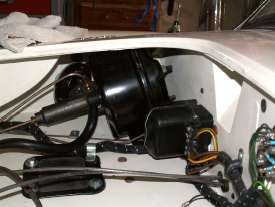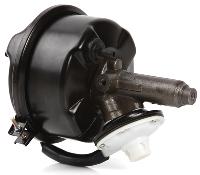The MGA With An Attitude
To UPGRADE, or Not To Upgrade? Power Booster - BT-200B
First things first. Keep in mind that a brake booster does nothing to improve the stopping ability of the brakes on the MGA. It only reduces the pedal force required for operation, and it also reduces tactile feedback (making the pedal feel a little spongy). MGA brakes are particularly good with either drum brakes or disc brakes. You can lock up the wheels at any speed, as long as the brakes are in good operating condition and not overheated. So the brake booster is a matter of personal choice, if you would like to reduce pedal force.


The most common type of booster unit used for the MGA is the remote vacuum powered booster. This does not connect directly to the brake pedal. It is installed downstream from the master cylinder, using fluid pressure output from the master cylinder to trigger the power boost function. It uses fluid only from the original master cylinder reservoir, so no additional reservoir is required.


A word of caution here. Installation instructions (266-KB pdf document) for the Delphi/Lockheed brake booster being sold by Moss Motors USA calls for a specific orientation for the booster unit. It wants to be situated at an angle slightly nose up (25 to 45 degrees), not level. It also calls for rotational orientation within 60 degrees of vertical, not sideways. This is likely to be necessary to assure proper bleeding of the unit to expel air from the fluid circuit, and it may be unique to the remote booster. I don't know if this applies to a remote booster from a different manufacturer. Just be aware the many of the pictures on following pages show the booster mounted in what would be incorrect orientation according to these instructions.

Another consideration is a matter of reliability. The brake booster is one additional part that introduces an additional possible mode of failure, so it may reduce the overall reliability of the car while increasing service requirements. There are a few different possible failure modes for the booster unit.
 1.) If the rubber diaphragm would crack it can lose its boost capability, usually just reverting to manual brake mode. 1.) If the rubber diaphragm would crack it can lose its boost capability, usually just reverting to manual brake mode.
 2.) A split diaphragm will also be a vacuum leak into the intake manifold, which will make the intake fuel mixture go lean, especially at low engine speed. The additional air flow might increase idle speed, or the weaker fuel mixture might make the engine stumble or stall (from idle speed). Running for a long time at moderate road speed with a vacuum leak and abnormal weak fuel mixture could ultimately result in hot running and burned valves. 2.) A split diaphragm will also be a vacuum leak into the intake manifold, which will make the intake fuel mixture go lean, especially at low engine speed. The additional air flow might increase idle speed, or the weaker fuel mixture might make the engine stumble or stall (from idle speed). Running for a long time at moderate road speed with a vacuum leak and abnormal weak fuel mixture could ultimately result in hot running and burned valves.
 3.) If the remote master cylinder would develop a leak of the rubber seal between the cylinder and the vacuum chamber, then brake fluid could be sucked out of the system to be passed into the intake manifold and burned. There may be no clue this is happening until the fluid level in the reservoir goes low enough to be sucking air, at which time you may suddenly lose the brakes. For this concern you might consider installing a fluid level warning device for the master cylinder. 3.) If the remote master cylinder would develop a leak of the rubber seal between the cylinder and the vacuum chamber, then brake fluid could be sucked out of the system to be passed into the intake manifold and burned. There may be no clue this is happening until the fluid level in the reservoir goes low enough to be sucking air, at which time you may suddenly lose the brakes. For this concern you might consider installing a fluid level warning device for the master cylinder.
If you convert the car to dual line braking system. Then you would need two remote brake boosters (as was done on the MGC). Alternate is to use a different type of booster unit that is actuated directly from the brake pedal (like post 1974 MGB). Any of this requires using a separate master cylinder for the hydraulic clutch, so this is a substantially involved modification to the car. Also the direct acting booster with master cylinder attached may not physically fit into the same space as the standard dual carburetor setup.
While the dual line braking system might be considered a safety feature, the power brake booster is simply a luxury option. It is my personal opinion that this sort of complexity (and additional weight) does not belong on a small light sports car (but each to his own).
|


